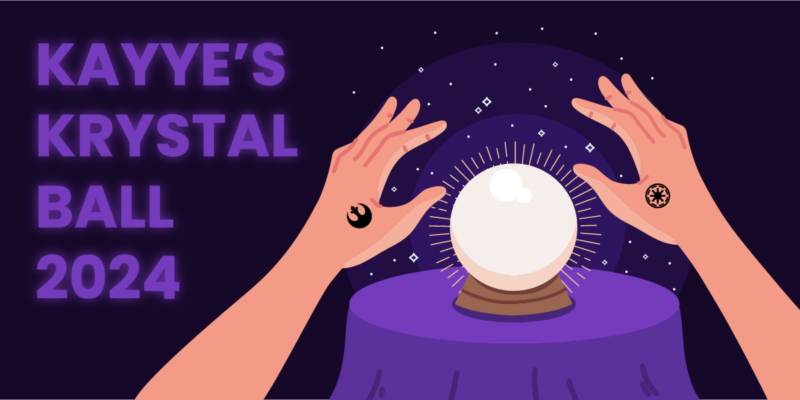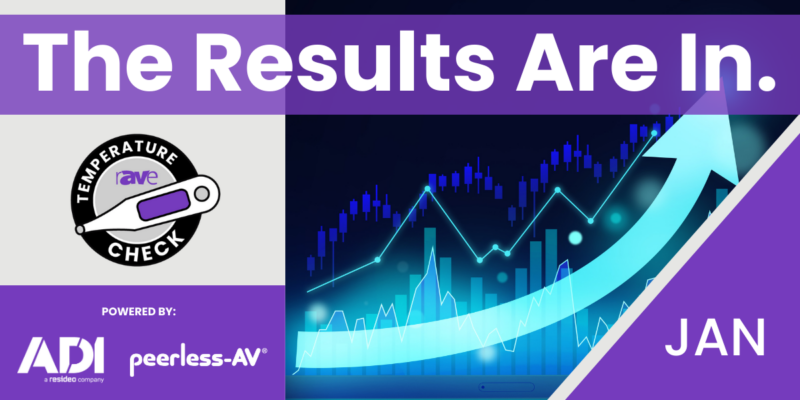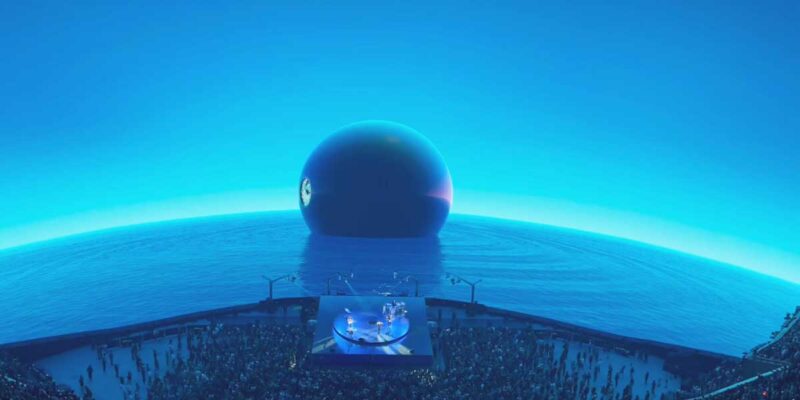THE BIGGEST Trend in AV in 2018 Will Be… Kayye’s Krystal Ball Is Back!

The year 2018 could turn out to be full of giant changes. The market is certainly poised for it as you have a number of technological advancements that have emerged simultaneously — each of them have a lot of potential. First, let’s review all the latest in emerging AV technology and then and I’ll tell you what I think will be the biggest one of them all in 2018, and why.
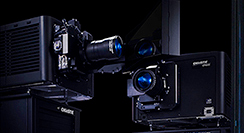 SSD Lighting: In the world of projection, both laser and LED lighting will hit the big-time in 2018. Although Christie Digital’s affirmation, last month, of Futuresource’s stat that 91 percent of the projectors sold in 2016 were still lamp-based, they have — along with nearly every other projector company — retooled its production lines for laser-based projection. If a company hasn’t done that, it’s most likely decided on the other leading SSD (solid-state device) lighting source, LED. SSD lighting will change everything in AV in 2018. And, I am not just talking about third-party relamping companies going out of business. I am saying that colorimetry will be revolutionary. Any — I mean ANY — side-by-side you do with a traditional lamp-based projector compared to a laser-based projector will win you the project for the replacement every single time (unless, of course, the customer doesn’t have the budget — and, in that case, why do the demo?). When given a reference to what the color reproduction from the original source is on lamp vs. laser, laser wins 100 percent of the time. With LED (vs lamp), it’s easily 90 percent of the time.
SSD Lighting: In the world of projection, both laser and LED lighting will hit the big-time in 2018. Although Christie Digital’s affirmation, last month, of Futuresource’s stat that 91 percent of the projectors sold in 2016 were still lamp-based, they have — along with nearly every other projector company — retooled its production lines for laser-based projection. If a company hasn’t done that, it’s most likely decided on the other leading SSD (solid-state device) lighting source, LED. SSD lighting will change everything in AV in 2018. And, I am not just talking about third-party relamping companies going out of business. I am saying that colorimetry will be revolutionary. Any — I mean ANY — side-by-side you do with a traditional lamp-based projector compared to a laser-based projector will win you the project for the replacement every single time (unless, of course, the customer doesn’t have the budget — and, in that case, why do the demo?). When given a reference to what the color reproduction from the original source is on lamp vs. laser, laser wins 100 percent of the time. With LED (vs lamp), it’s easily 90 percent of the time.
But, SSD isn’t all about color — tt’s about lifetimes too. Most laser- and LED-based projectors, no matter the brand, are being spec’d at 20,000+ hours of operation — and some are even reaching the 30K hour mark. This simply blows away any lamp-based projection model. Everyone will want to upgrade.
But not everyone will be able to afford it. And, although SSD lighting will be the largest trend in projection, it won’t be the biggest thing in AV for 2018 — so keep reading.
 Direct-View LEDs: It drives me — and about about 85,000 other AV professionals — crazy when I see ads on TV or even in our own trade publications touting the new generation LCD displays as LEDs. They aren’t LEDs. There’s a big difference between LED-lit LCDs and actual LED displays. Sure, LED-lit LCDs are awesome and way, way better than CFL-lit LCDs — who would’t buy an LED-based LCD monitor or TV today? LEDs last longer, have way, way less uniformity issues and much better colorimetry than any other backlighting technology for LCD monitors. But, they aren’t LEDs. LEDs will be big in 2018 and we need to stop the confusing the customer with our nomenclature as since they are, in fact, very different from LED-lit LCDs.
Direct-View LEDs: It drives me — and about about 85,000 other AV professionals — crazy when I see ads on TV or even in our own trade publications touting the new generation LCD displays as LEDs. They aren’t LEDs. There’s a big difference between LED-lit LCDs and actual LED displays. Sure, LED-lit LCDs are awesome and way, way better than CFL-lit LCDs — who would’t buy an LED-based LCD monitor or TV today? LEDs last longer, have way, way less uniformity issues and much better colorimetry than any other backlighting technology for LCD monitors. But, they aren’t LEDs. LEDs will be big in 2018 and we need to stop the confusing the customer with our nomenclature as since they are, in fact, very different from LED-lit LCDs.
The big thing for LCDs in 2018 will be how they continue to get thinner, cheaper and lighter while also getting brighter. We’ll see brightness go up 30 percent in 2018, we’ll see prices reduced nearly 50 percent from mid-2017 pricing and we’ll see a plethora of 75″+ displays hit the market by mid-year — all at half what they cost now. But this won’t be the biggest thing to happen to AV in 2018. So keep reading.

LEDs: If I were starting new business in the market right now, I’d start an advertising agency that specializes in content for LED displays — this is the next big thing in advertising. The entire digital signage space will be revolutionized by LED and much of it will start to happen in 2018. In places where we were putting LCDs before (e.g., menu boards, drive-thrus, transportation signage and retail video walls)m LEDs will swallow up the market. I mean, LEDs will dominate nearly every direct-view display conversation and will certainly own 60 percent recent of the video wall market by the end of 2018. And because they are SSD, they too will have colorimetry that’s significantly better than LCD. In many cases we’re actually having to run the LED panels at 40-60 percent of their potential brightness because they’re too bright — so really will last forever. Yet, even with all that happening in 2018, LEDs will still not be the biggest thing to effect the AV market in 2018. So keep reading.
OLED: So far, LG is kicking butt with OLED. LG’s Wallpaper display is the one everyone wants for direct-view installs, but it’s still very expensive. But if the client wants perfect colorimetry throughout their signage network or in conference room, there’s only one choice in direct-view and that’s OLED. No one sees it and doesn’t think so — even LG’s competitors. However, issues like so-called burn-in, 24/7/365 operation limitations and cost will relegate OLED to the very high-end of display technologies. Companies like LG and Sony will be perfectly fine with that as they  improve from generation to generation. OLED will accomplish 24/7/365 operation in 2018 without burn-in and pricing will fall. But even with all that happening, it’s not the biggest overall trend of 2018. What is? Keep reading — and no peeking ahead.
improve from generation to generation. OLED will accomplish 24/7/365 operation in 2018 without burn-in and pricing will fall. But even with all that happening, it’s not the biggest overall trend of 2018. What is? Keep reading — and no peeking ahead.
4K to 8K: Every single friend I have — whether they are in the AV market or not, wants a 4K TV. I live in a liberal arts college town full of non-techie types that see me as their only tech outlet and I get asked, all the time, about 4K TVs. Heck, even my parents went out over the holidays and purchased a 4K TV from Samsung — the QLED Q7 series. It looks amazing — even with old-timey 1080p coming from their AppleTV. But, all this talk in our market about 4K will diminish when Sharp debuts an entire line of 8K displays at CES next month. This introduction will garner much of the CES attention worldwide and will help put Sharp right back on the big-time monitor-map as an alternative for more than just their collaboration systems, dubbed AQUOS BOARDS. 8K will be big for Sharp.
However, just because you can display it, doesn’t mean you can use it yet. 8K will mostly be relegated to demo-land and wow-factor applications. So, although you will see it garner a lot of attention in 2018, routing signals will be difficult (in fact, currently, the Extron XTP II CrossPoint Series is the only switching system able to route 8K without compressing it because of its 50 Gbps digital backplane). 8K will impress, no doubt, but it won’t be the biggest trend in AV for 2018. So again, keep reading.
 BYOD & Collaboration: Thanks to Barco and its ClickShare systems that debuted in 2012, a new market was spawned for wireless transmission systems — heck, Barco even bought one of them: WePresent. 2018 saw the launch of the first 4K BYOD system in the Barco CSE-800 and a few others have followed as well. Barco will continue to own the largest market share for stand-alone BYOD systems in 2018 and watch for them to launch a more cloud-friendly version this year (more on that later).
BYOD & Collaboration: Thanks to Barco and its ClickShare systems that debuted in 2012, a new market was spawned for wireless transmission systems — heck, Barco even bought one of them: WePresent. 2018 saw the launch of the first 4K BYOD system in the Barco CSE-800 and a few others have followed as well. Barco will continue to own the largest market share for stand-alone BYOD systems in 2018 and watch for them to launch a more cloud-friendly version this year (more on that later).
But, 2017 spawned an even bigger segment for AV than BYOD that will get even bigger in 2018. Dubbed the collaboration board by this very author when the segment found its way to the mainstream market, these are mostly direct-view LCDs that include white boarding, annotation and wireless sharing. They are integrated with cloud-based video- and audio-conferencing (without a PC), most have a USB camera and all of them include multi-touch  interfaces. Infocus and Sharp didn’t totally invent the category a few years ago with respective launches of the Mondopad and the AQUOS BOARD, but they certainly set the bar for what was to come. And, 2017 saw nearly 15 new companies enter the market with collaboration boards — now everyone from Google to Sony has one. Name any display company and they have one. The biggest surprise here wasn’t a flat-panel manufacturer but projector manufacturer EPSON. The company’s BrightLink Pro, once aimed only at the higher-ed market, grew exponentially in 2017 because of two factors: They launched a corporate version and they added laser-projection models.
interfaces. Infocus and Sharp didn’t totally invent the category a few years ago with respective launches of the Mondopad and the AQUOS BOARD, but they certainly set the bar for what was to come. And, 2017 saw nearly 15 new companies enter the market with collaboration boards — now everyone from Google to Sony has one. Name any display company and they have one. The biggest surprise here wasn’t a flat-panel manufacturer but projector manufacturer EPSON. The company’s BrightLink Pro, once aimed only at the higher-ed market, grew exponentially in 2017 because of two factors: They launched a corporate version and they added laser-projection models.
You can also expect to see digital canvas pioneers Nureva launch laser and higher resolution models this year as well. This market will explode in 2018. Everyone will be talking about collaboration, again, this year and the number of companies and products won’t contract one bit — you will see more, in fact. This will, no doubt, be the largest growth segment of the AV market for 2018 but it’s the second largest big-trend of the year. So read on.
 AV-over-IP: Network-based AV, AVIT, AVN — whatever you want to call it, AV-over-IP is coming and coming fast — maybe faster than we all thought? In all honesty here, there are segments of the AV market that are all-in when it comes to an AV-over-IP future (like higher-education) and there are segments that are still in the “not yet” stage (like the corporate AV market). The adoption of AV-over-IP might even be outpacing supply as there are very few alternatives. The SDVoE (Software Defined Video Over Ethernet) protocol based on the Aptovision chip reference design is the leading technology out there due, in part, to their 25+ partners building (including companies like Sony, Christie, DVIGear, iMAGsystems, Aurora and Belden) and also, in my opinion, to their savvy hiring of industry-leader Justin Kennington. Justin has set a great vision and organizational system in motion over at the SDVoE Alliance and they are the system that will likely emerge at the end of 2018 as the leading sales of AV-over-IP systems — passing industry leader SVSi.
AV-over-IP: Network-based AV, AVIT, AVN — whatever you want to call it, AV-over-IP is coming and coming fast — maybe faster than we all thought? In all honesty here, there are segments of the AV market that are all-in when it comes to an AV-over-IP future (like higher-education) and there are segments that are still in the “not yet” stage (like the corporate AV market). The adoption of AV-over-IP might even be outpacing supply as there are very few alternatives. The SDVoE (Software Defined Video Over Ethernet) protocol based on the Aptovision chip reference design is the leading technology out there due, in part, to their 25+ partners building (including companies like Sony, Christie, DVIGear, iMAGsystems, Aurora and Belden) and also, in my opinion, to their savvy hiring of industry-leader Justin Kennington. Justin has set a great vision and organizational system in motion over at the SDVoE Alliance and they are the system that will likely emerge at the end of 2018 as the leading sales of AV-over-IP systems — passing industry leader SVSi.
That said, the AV-over-IP market will literally explode and change the landscape WHEN Extron and Crestron BOTH have a family of AV-over-IP offerings. In fact, they will likely help validate the market shift towards IP. Crestron has one line, so far, in the NVX series using JPEG 2000 over a 1Gig network, but expect to see more in 2018. Certainly AV-over-IP won’t come close to 10 percent of the signal routing market by the end of 2018, but we could see one or two clear leading systems or direction site market is going — setting up for 2019 or 2020 to be the big-shift to move it all to the network.
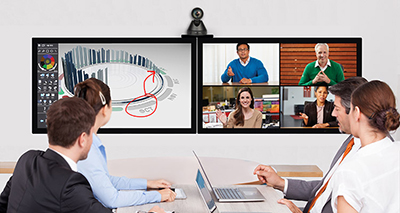 The VTC Cloud: Desktop videoconferencing has been around for years, but 2017 was the year it truly became mainstream with, mostly, Zoom Video Communicaitons and Skype for Business, dominating the discussion — so much so that both Cisco and Polycom partnered with them. And, Zoom was savvy enough to have even worked deals with companies like Creston — who integrated Zoom into their Mercury huddle room system as well as Logitech, box and Slack. Although Cisco is still the market leader in videoconferencing, Zoom isn’t far behind them — along with Skype (aka Microsoft), BlueJeans and newbie (at least in this segment) Google. What this all means is that the video call is going in the cloud. Zoom just needs a PC (or something like it that can connect it to the Internet) and a USB camera — that can be a 720p, 1080p our even a 4K USB camera. You can even make 4K calls! The days of the hardware-based solution is numbered and 2018 will put most of the proverbial nails in that coffin.
The VTC Cloud: Desktop videoconferencing has been around for years, but 2017 was the year it truly became mainstream with, mostly, Zoom Video Communicaitons and Skype for Business, dominating the discussion — so much so that both Cisco and Polycom partnered with them. And, Zoom was savvy enough to have even worked deals with companies like Creston — who integrated Zoom into their Mercury huddle room system as well as Logitech, box and Slack. Although Cisco is still the market leader in videoconferencing, Zoom isn’t far behind them — along with Skype (aka Microsoft), BlueJeans and newbie (at least in this segment) Google. What this all means is that the video call is going in the cloud. Zoom just needs a PC (or something like it that can connect it to the Internet) and a USB camera — that can be a 720p, 1080p our even a 4K USB camera. You can even make 4K calls! The days of the hardware-based solution is numbered and 2018 will put most of the proverbial nails in that coffin.
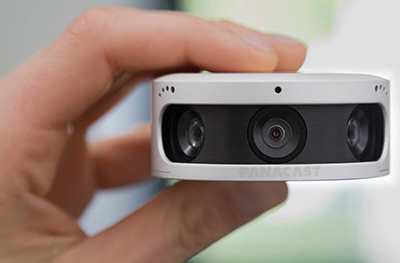 And, speaking of the 4K call, a tiny unknown company called Altia Systems — you’ve probably never heard of them but probably heard of their product, the Panacast USB camera — took advantage of the concept of the 4K video call and created a 180-degree field-of-view USB camera that allows everyone in a room to be seen on a video call — even when sitting right up next to the screen. This, along with the new Logitech 4K Brio and MeetUp USB cameras, turn Skype, Zoom and BlueJeans into the “this is more than good enough” videoconferencing system for more than 90 percent of the users.
And, speaking of the 4K call, a tiny unknown company called Altia Systems — you’ve probably never heard of them but probably heard of their product, the Panacast USB camera — took advantage of the concept of the 4K video call and created a 180-degree field-of-view USB camera that allows everyone in a room to be seen on a video call — even when sitting right up next to the screen. This, along with the new Logitech 4K Brio and MeetUp USB cameras, turn Skype, Zoom and BlueJeans into the “this is more than good enough” videoconferencing system for more than 90 percent of the users.
2018 will see more USB cameras, a new, giant company enter the so-called soft-codec (cloud-based conferencing) market and a nearly total shift away from hardware-based codecs. This is still not the biggest of all new trends of 2018. But what’s next is!
AVaaS: AV as a Service. Maybe you’ve heard of it, maybe you haven’t. But you will. And you’ll start doing it in 2018. The future of everything we do is in services and customers love this concept. It takes the confusion, complexity and caution out of buying AV gear from them. It simplifies your AV lines (as you can build all your AV systems with just a few lines rather than having to carry hundreds of brands), allows you to always specify what you want (and what you can best control and maintain) and sets you up to OWN the client relationship. Basically, to simplify it — your customer would be leasing each system from you rather than buying it. And, as long as it did what they wanted, was simple to use and worked when they need it, they won’t care what you use. So, you are in control of it all.
Look, AVaaS requires much more than a few paragraphs in a future-looking product round-up, and I will write about it a lot in 2018 as it emerges, but, here’s the basic concept:
AVaaS is where all the AV hardware, software, programming and integration services are paid on a recurring basis — maybe annually, quarterly or even monthly. The customer will like this as it removes the risk of owning a depreciating asset that is generally locally managed. And, you will like this as, since you are the owner, technically, of the AV gear, you become their in-house AV company — their go-to for all AV needs. Most of your clients have been using this model in some capacity for years for both IT and furniture. But, in the AV space, until now, we’ve pretty much only applied it to services — selling recurring service or maintenance contracts — and sometimes proactive monitoring, too. But why not everything?
 The obvious response right now, from the integrator who may be reading and pondering this is that they can’t afford to finance the AV gear — you can’t afford to buy it all and lease it, in a sense, to the customer. But, you can. Basically, you form a relationship with a leasing company, you slightly mark-up their service and then resell it to the client. But, you also get to roll-up the programming, software licenses and integration fees (and maintenance, if you want) into one recurring fee. The advantages are huge — the obvious ones are, as I said, you own the relationship with the client. Since you’re managing and charging them regularly for the training rooms, why not use you for their meeting rooms too? And, and this is the biggie, you get to ALWAYS pick the the right AV gear for them. This will significantly reduce your overhead, eventually, as you can basically standardize on a set of AV gear you always use for every system. OK, maybe not all of it — but certainly 90+ percent of it. This means you will know that set of gear inside out: how it works, what its idiosyncrasies are, what its tolerances are, etc. — you’ll know those systems so well you’ll know before something happens what’s likely to happen. Servicing identical systems becomes easier and more profitable — especially if you’re good at selling services and/or proactive maintenance plans. Ssimplifying your systems means you’re carrying fewer brands, have fewer SKUs, spend less time finding a product that does something unique for the client and spend less time differentiating each system. In an AVaaS model, leasing programming becomes, legally and technically possible — and very profitable. There’s no question who owns the code.
The obvious response right now, from the integrator who may be reading and pondering this is that they can’t afford to finance the AV gear — you can’t afford to buy it all and lease it, in a sense, to the customer. But, you can. Basically, you form a relationship with a leasing company, you slightly mark-up their service and then resell it to the client. But, you also get to roll-up the programming, software licenses and integration fees (and maintenance, if you want) into one recurring fee. The advantages are huge — the obvious ones are, as I said, you own the relationship with the client. Since you’re managing and charging them regularly for the training rooms, why not use you for their meeting rooms too? And, and this is the biggie, you get to ALWAYS pick the the right AV gear for them. This will significantly reduce your overhead, eventually, as you can basically standardize on a set of AV gear you always use for every system. OK, maybe not all of it — but certainly 90+ percent of it. This means you will know that set of gear inside out: how it works, what its idiosyncrasies are, what its tolerances are, etc. — you’ll know those systems so well you’ll know before something happens what’s likely to happen. Servicing identical systems becomes easier and more profitable — especially if you’re good at selling services and/or proactive maintenance plans. Ssimplifying your systems means you’re carrying fewer brands, have fewer SKUs, spend less time finding a product that does something unique for the client and spend less time differentiating each system. In an AVaaS model, leasing programming becomes, legally and technically possible — and very profitable. There’s no question who owns the code.
AVaaS will be HUGE. The clients will start to demand it, eventually. So, consider adopting it now — be a pioneer and, if you don’t know how to do it, ask! AVaaS will be THE BIG THING everyone starts to talk about in 2018 and it’s my pick for the biggest new trend for the new year.
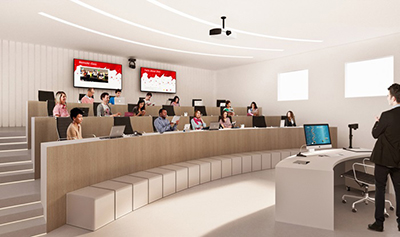 An Honorable Mention – Digital Content Management: Back in October of 2017, Barco issued a press release on a new version of its higher-ed focused WeConnect system. In that press release was a barely-mentioned “Digital Engagement Platform.” But, that mention didn’t go unnoticed by us. This is foreshadowing the direction Barco believes the future of the AV market is heading — content management. The press release describes the Digital Engagement Platform as a digital collaborative portal allowing clients to manage their WeConnect subscriptions over the internet. Translation: Barco has set up an online system to manage content that doesn’t require a locally-hosted network AND they’re even setting up WeConnect as an AVaaS product that has a sort of a seat-license to use it.
An Honorable Mention – Digital Content Management: Back in October of 2017, Barco issued a press release on a new version of its higher-ed focused WeConnect system. In that press release was a barely-mentioned “Digital Engagement Platform.” But, that mention didn’t go unnoticed by us. This is foreshadowing the direction Barco believes the future of the AV market is heading — content management. The press release describes the Digital Engagement Platform as a digital collaborative portal allowing clients to manage their WeConnect subscriptions over the internet. Translation: Barco has set up an online system to manage content that doesn’t require a locally-hosted network AND they’re even setting up WeConnect as an AVaaS product that has a sort of a seat-license to use it.
Maybe this was intentional or maybe it wasn’t. But you can be sure that every major AV manufacturer who currently does signal routing and management did notice — or at the very least, is looking at integrating such a platform themselves. This is all part of the future, forthcoming AVaaS model and this would even stack on content management — the holy grail (think AppleTV for the corporation) — the AppleTV is his the device and all the content management is the secret sauce. Or, put another way, the Amazon Dot or Echo is only the cheap interface to the intellectual-property-rich Alexa platform. The value of the Digital Engagement Platform is, in fact, intellectual property!
That’s it! I hope you enjoy this and will share it on social. Please also post it in your cubical or office and track it for accuracy. I’m curious what you think too! So comment below and let us know your thoughts.



